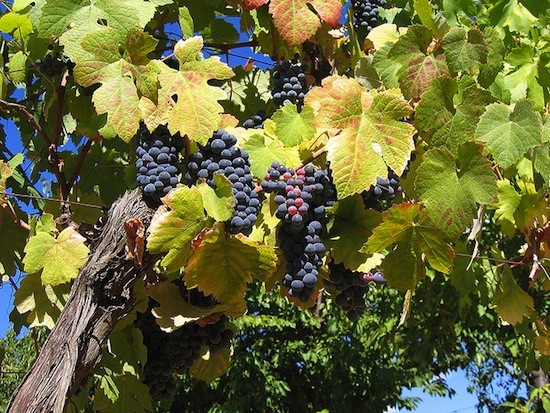
Every wine-producing region in the world produces table grapes; in California, the hotter and drier the climate, the sweeter the table grapes. Table grapes can be grown in places too hot or dry for good wine grapes; the sweetness overpowers the terroir so prized by wine snobs gurus.
Just as the vendange (the picking of the grapes) happens in wine country, it happens in table grape country, and since Orange County is smack in the middle of a great deal of table grape country, we see a lot of grapes at our farmers' markets at this time of year.
]
The two biggest-selling varieties of table grapes are Thompson Seedless (green or “white”) and Flame Seedless (red). Almost every single grape, even at a farmers' market stand, will be one of these two.
Though the seedless varieties have huge, sweet berries unmatched by the sad specimens lying in careless clumps at the chain grocery stores, the real flavor in the grape world comes from the seeded varieties.
Even something as simple as the Red Globe, an enormous red grape larger than a sweet cherry, can reveal worlds of taste that have nearly gone by the wayside as the seedless varieties eat up market share. It's worth spitting out the tiny pips. Black Corinth is another variety, with tiny fruit. These are sometimes marketed as “Champagne” grapes, but they are not used to make wine (in Champagne or out); when dried, they become Zanté currants.
Muscadines, the traditional grape of North Carolina and the Southeast, have made their way to California and some markets are carrying them. They are deep purple grapes, nearly black, with the toughest skin in grapedom: to eat them, cut a slit in the grape and suck out the middle. Large green muscadines are usually called scuppernongs; buy some if you can find them and be transported to To Kill A Mockingbird.
The latest grape to captivate farmers' market patrons, however, is a Japanese variety called Kyoho. It has large, dark purple berries and huge seeds inside. Almost uniquely among table grapes, Kyohos are traditionally peeled (the skin is very loose, so this is not the painstaking task it sounds). The taste is like a fresh version of the grape jelly we all grew up eating, because Kyoho is a Concord grape cross.

